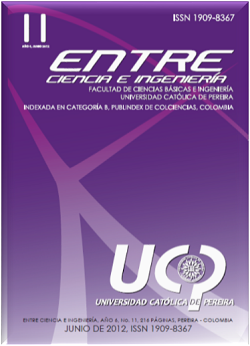Mechanical Properties Simulation of Ti-based Hard Multilayers by Using the Finite Elements Method
Keywords:
mechanical properties, stress, nanoindentation, bilayersAbstract
In this paper, mechanical behavior of TiAlV/TiAlVN bilayers was studied by means of nanoindentation experiment simulated using ANSYS software. In the simulations, a Vickers type diamond tip, a steel substrate and TiAlV/TiAlVN bilayers distributed in a constant thickness of 2 μm by an axisymmetric geometry were considered. The parameters used in the simulation as Young’s modulus E, Poisson ratio ν and yield stress σe for TiAlV and TiAlVN were 113.6 GPa and 350 GPa, 0.342 and 0.2, and 830 MPa and 870 MPa respectively. Results showed the radial stress distribution seems to be tooth -like and the maximum shear stress decreased as the number of bilayers increased
References
Abdul-Baqui A., van der Giessen E., (2001). “Indentation-induced Interface Delamination of a Strong Film on a Ductile Substrate”, Thin Solid Films Vol. 381, pp. 143-154.
Amaya-Roncancio S., Restrepo-Parra E., (2008). “Finite Elements Modeling of Multilayers of Cr/CrN”, Microelect. J., Vol.39, pp. 1336–1338.
Bauer S., Schmuki P., van der Mark K., Park J., (2012). “Engineering Biocompatible Implant Surfaces, Engineering Biocompatible Implant Surfaces” Progress Mater. Sci., In Press.
Chawla V., Jayaganthan R., Chandra R. (2008). “Finite Element Analysis of Thermal Stress in Magnetron Sputtered Ti Coating”, J. mater. Proc. Technol., Vol. 200, pp. 205–211.
Chen X., Xiang Y., Vlassak J.J. (2006). “A Novel Technique of Measuring the Mechanical Properties of Porous Materials by Nanoindentation: with Application to Low-k Dielectric Thin Films”, J. Mater. Res. Vol. 21, No. 3, pp.715-724.
Cheng Y.-T., Cheng C.-M., (1998). “Further Analysis of Indentation Loading Curves: Effects of Tip Imperfection on Mechanical Property Measurements”, J. Mater. Res. Vol. 13, pp.1059-1065.
Cheng Y.-T., Cheng C.-M. (1999). “Scaling Relationships in Conical Indentation of Elastic-Perfectly Plastic Solids”, Int. J. Solids Struct., Vol. 36, pp. 1231-1243.
Cheng Y.-T., Cheng C.-M. (1999). “Can Stress–Strain Relationships Be Obtained from Indentation Curves Using Conical and Pyramidal Indenters?”, J. Mater. Res. Vol. 14, pp. 3493-3496.
Cheng Y.T., Cheng C.M. (2004). “Scaling, Dimensional Analysis, and Indentation Measurements”, Mater. Sci. Eng. R. Vol. 44, pp.91- 149.
Dao M., Chollacoop N., Van Vliet K.J. Venkatesh T.A., Suresh S. (2001). “Computational Modeling of the Forward and Reverse Problems in Instrumented Sharp Indentation” Acta Mater. Vol. 49, pp. 3899- 3918.
Doerner F., Nix W.D. (1986). “A Method for Interpreting the Data from Depth- Sensing Indentation Instruments”, J. Mater. Res. Vol. 1, pp. 601-605.
Efeoglu I. (1993). “The Mechanical and Tribological Properties of Ceramic Sputter Ion Plated Coating”, PhD Thesis, Dept. of Aero and Mech. Eng., University of Salford, UK.
Engineering tool box (October, 2012), http://www.engineeringtoolbox. Com
Fischer-Cripps AC. (2002). “Nanoindentation”. New York: Springer.
Gong J., Wu J., Guan Z., (1999). “Examination of the Indentation Size Effect in Low-load Vickers Hardness Testing of Ceramics”, J. Europ. Soc., Vol.19, pp 2625-2631.
He J.L., Veprek S., (2003). “Finite Element Modeling of Indentation into Superhard Coatings”. Surf. Coat. Tech. Vol. 163 –164, pp. 374– 379.
Hermann AJ, Hofmann S. (1987). “Surface and Interface Characterization of Heat-Treated (TiAl) N Coatings on High Speed Steel Substrates”, Proceedings, Inter. Conf. Metal. Coat., San Diego, CA, USA, pp. 23– 24.
Klein C. A., (1992). “Anisotropy of Young’s Modulus and Poisson’s Ratio in Diamond”, Mater. Res. Bull., Vol. 27. No.12, pp.1407-1414.
Knapp J.A., Follstaedt D.M., Barbour J.C., Myers S.M. (1997). “Finiteelement Modeling of Nanoindentation for Determining the Mechanical Properties of Implanted Layers and Thin Films”, Nucl. Instrum. Methods B, Vol. 127-128, pp 935-939.
Knapp J.A., Follstaedt D.M., Myers S.M., Barbour J.C., Friedmann T.A. (1999). “Finite-element Modeling of Nanoindentation”, J. Appl. Phys. Vol. 85, pp.1460-1474.
Knotek O, Munz WD, Leyendecker T. (1987). “Industrial Deposition of Binary, Ternary, and Quaternary Nitride of Ti, Zr, and Al”, J Vac Sci Technol, A, Vol. 5, pp. 2173–2179.
Lichinchi M., Leonardi C., Haupt J., Vitali R., (1998). “Simulation of Berkovich Nanoindentation Experiments on Thin Films Using Finite Element Method”, Thin Solid Films, Vol. 312, pp. 240-248.
Oliver W.C., Pharr G.M., (1992). “An Improved Technique for Determining Hardness and Elastic Modulus Using Load and Displacement Sensing Indentation Experiments”, J. Mater. Res. Vol. 7, pp. 1564-1583.
Poláková H., Musil J., Vlc¡ek J., Allaart J., Mitter C., (2003). “Structurehardness Relations in Sputtered Ti–Al–V–N films”, Thin Solid Films, Vol. 444, pp.189–198.
Randhawa H, Johnson PC, Curigham R. (1998). “Deposition and Characterization of Ternary Nitrides”, J Vac Sci Technol, A Vol. 6, pp. 2136–2139.
Sun Y., Bell T., Zheng S., (1995). “Finite Element Analysis of the Critical Ratio of Coating Thickness to Indentation Depth for Coating Property Measurements by Nanoindentation”, Thin Solid Films, Vol. 258, pp. 198-204.
Tang G., Shen Y.-L. Singh D.R.P., Chawla N. (2010). “Indentation Behavior of Metal–Ceramic Multilayers at the Nanoscale: Numerical Analysis and Experimental Verification”, Acta Mater. Vol. 58, pp. 2033–2044.
Tsui T.Y., Vlassak J.J., Nix W.D. (1999). “Indentation Plastic Displacement Field: Part I. The Case of Soft Films on Hard Substrates”. J. Mater. Res. Vol. 14, pp. 2196.
Vieira M.T., Ramos A.S., (1999). “The Influence of Ductile Interlayers on the Mechanical Performance of Tungsten Nitride Coatings”, J. Mater. Proc. Technol. Vol. 92-93, pp. 156-161.
Xie Z. H., Sing R., Bendavid A., Martin P., Munroe P., Hoffman M., (2007). “Contact Damage Evolution in a Diamond-Like Carbon (DLC) Coating on a Stainless Steel Substrate”, Thin Solid Films, Vol. 515, pp. 3196-3201.
Zhao, X., Xie, Z., Munroe, P., (2011). “Nanoindentation of Hard Multilayer Coatings: Finite Element Modeling”, Mater. Sci. Eng. A, Vol. 528, No. 3, pp. 1111-1116.








 Revista Entre Ciencia e Ingeniería
Revista Entre Ciencia e Ingeniería .png) entrecei@ucp.edu.co
entrecei@ucp.edu.co.png) ISSN (Impreso) 1909-8367 - ISSN (En Línea) 2539-4169
ISSN (Impreso) 1909-8367 - ISSN (En Línea) 2539-4169 Attribution-NonCommercial 4.0 International (CC By-NC 4.0)
Attribution-NonCommercial 4.0 International (CC By-NC 4.0)
.png) Carrera 21 No. 49-95 Av. de las Américas, Pereira, Risaralda, Colombia
Carrera 21 No. 49-95 Av. de las Américas, Pereira, Risaralda, Colombia